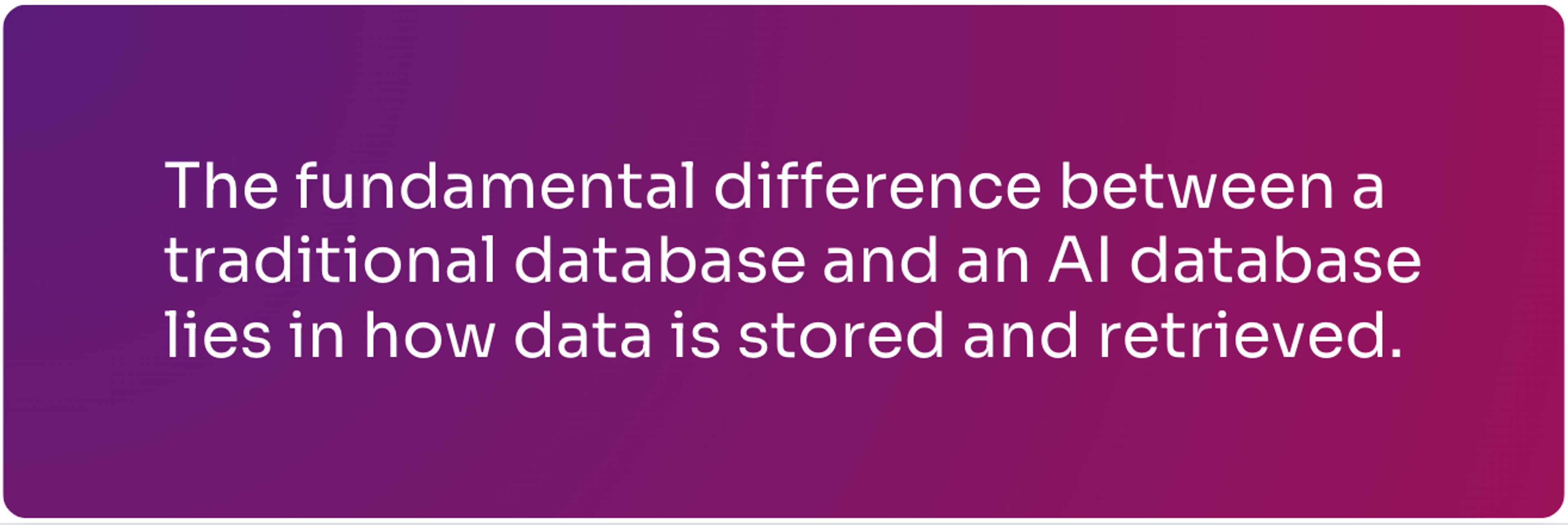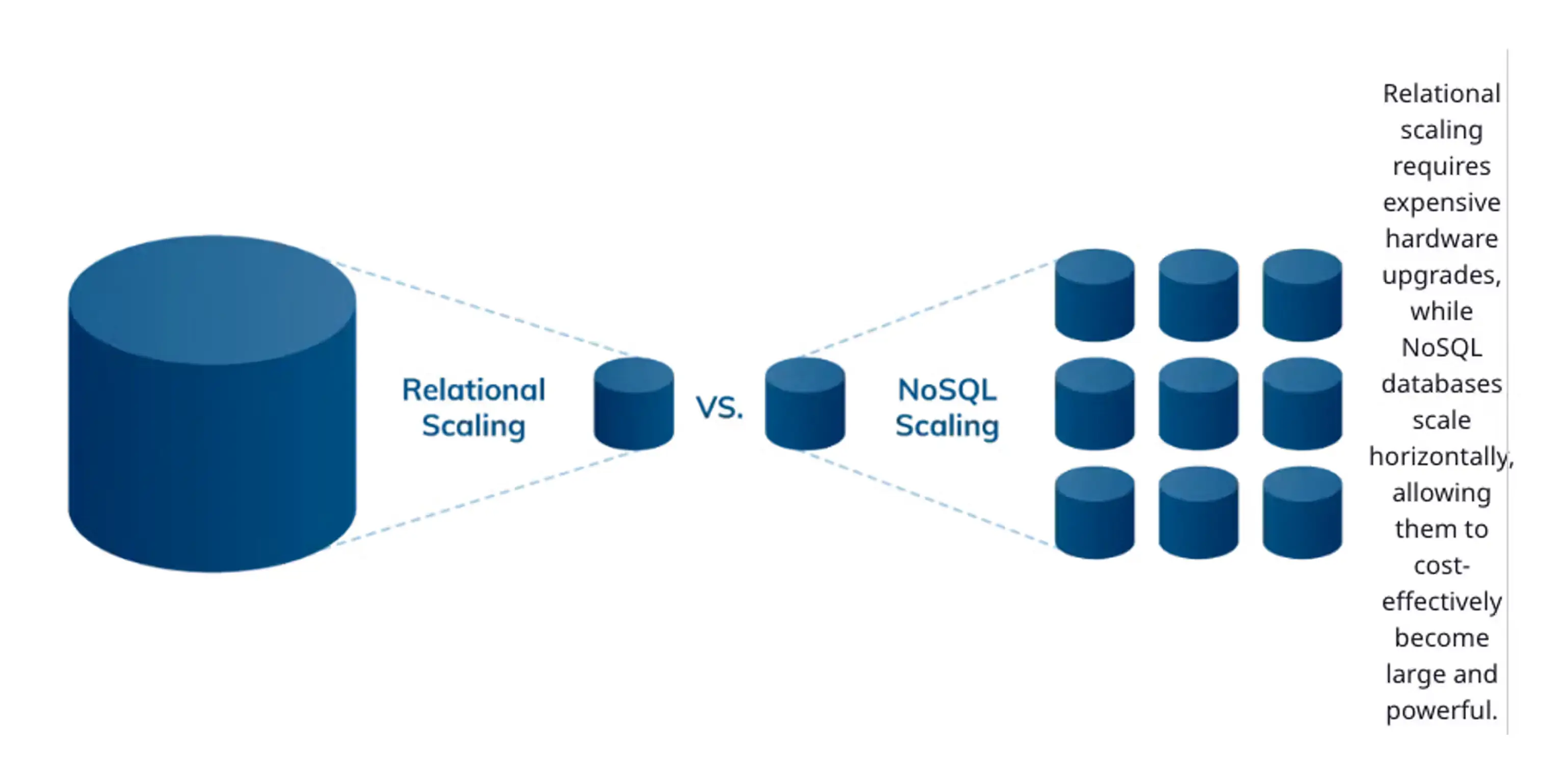Generative AI is one of the more important technological innovations in the last few years because tools like ChatGPT (released in Nov 2022) have exploded in popularity, showing the world the transformative potential of generative AI.
AI databases are a specialized approach to database systems, tuned specifically for
- artificial intelligence
- machine learning
- deep learning applications.
Unlike traditional databases, AI databases handle large, complex datasets. They ingest, analyze, and retrieve data rapidly.
This comprehensive guide breaks down the key features of AI databases, looking at
- types
- benefits
- real-world applications
- adoption challenges.
By the end, you’ll know how to choose the right AI database for your application.

Understanding the foundation of AI databases
AI databases are a significant evolution in data management.
They are tailored to meet the demands of artificial intelligence and machine learning applications. Traditional database systems excel at handling structured and tabular data with predefined schemas, but these new AI databases are purpose-built to manage diverse, complex, and often unstructured data types efficiently.
The fundamental difference lies in how data is stored and retrieved.
A traditional (or relational) database stores information in tables, rows, and columns, making it fast and easy to look up predefined criteria. But relational databases struggle with similarity tasks, which are crucial for many AI applications.
Similarity is at the heart of RAG-enabled (retrieval-augmented generation) AI applications, powered by large language models (LLMs).
Traditional databases rely on exact matching, but an AI database stores data as a mathematical vector: an abstract representation of data generated through machine learning. Vector similarity search happens with remarkable speed and accuracy using approximate nearest neighbor (ANN) algorithms. What’s more, AI databases horizontally scale out (add more nodes) and vertically scale up (increase memory and storage resources), so they accommodate massive volumes of data across distributed systems more effectively than their traditional counterparts.
This scalability is essential to handle the ever-growing datasets that fuel modern AI and machine learning models.

Key features of AI databases
AI databases, like Astra DB powered by Apache Cassandra®, are ideal for powering intelligent applications with high throughput. They integrate seamlessly with ML frameworks, graphs, and advanced analytics like statistics, patterns, and anomalies. And they scale as required, making them a desired tool for modern GenAI developers
Let's explore the key characteristics of AI databases that make them well suited to solve performance issues tied to other databases:
Vector storage
A defining feature of AI databases is their ability to store and process data as high-dimensional vectors by passing them through an embedding model.

Rapid vector-based similarity search efficiently handles complex data representations crucial for many AI and machine learning applications.
Automated data analysis
AI databases excel at automating complex data analysis tasks. They automatically identify patterns, relationships, and insights within vast datasets, a process that’s time-consuming or nearly impossible with traditional systems. Discovering hidden trends quickly leads to prompt decisions.
Scalability
Built for horizontal scalability, AI databases handle massive volumes of enterprise data (often in millions of rows) across distributed systems. Organizations grow their data infrastructure seamlessly as needs evolve, avoiding the scalability limitations of traditional databases.
Flexibility
By design, AI databases manage diverse data types, including
- structured data
- semi-structured data
- unstructured data.
By embedding this data in a vector space, an AI DB adapts to AI and machine learning workloads, accommodating
- text
- images
- video
- sensor
- time-series data
- complex numerical data.
Moreover, this flexibility means you can further generate accurate synthetic data to fine tune AI models.

Natural language processing and complex query support
These databases support sophisticated query mechanisms optimized for AI workloads. They handle complex, multidimensional queries, similarity searches, and data science processes with remarkable speed. They answer questions by searching for the most similar documents based on a natural language query, which forms the backbone of RAG applications. And analytics happen in real-time.
Machine learning integration
Beyond LLM-based applications, AI databases provide essential functionality for traditional machine learning tasks such as a recommendation system or a search engine. By storing data points in vector space, developers quickly create and evaluate ML models, leveraging the database's built-in capabilities for efficient similarity computations.
Parallel processing
AI databases are engineered with scale in mind. Parallel processing architectures and distributed computing address the ever-growing demands of semantic search and other intensive AI tasks.

Types of AI databases
Different types of AI databases cater to different needs and applications. So which one is best for your project? Let’s look at the characteristics, advantages, and ideal use cases.
Relational databases with AI capabilities
Traditional relational databases (RDBMS), such as MySQL and PostgreSQL, use AI-based extensions to incorporate and support machine learning algorithms and deep learning applications to enhance their strength: handling structured data.
NoSQL databases optimized for AI workloads
NoSQL databases like MongoDB and Apache Cassandra® have been optimized to handle large volumes of unstructured or semi-structured data common in AI applications, offering flexible schema designs and high scalability.
Graph databases for AI
Designed to store and query complex relationships between data entities, graph databases like Amazon Neptune are particularly useful in AI applications that use knowledge graphs, social network analysis, and recommendation systems. Recent research on graph RAG demonstrates their potential to build knowledge graphs from documents for context and generation tasks.
Time-series databases for AI
Open-source databases like InfluxDB and TimescaleDB are optimized to store and analyze large volumes of time-stamped data. These are particularly useful in AI applications that need real-time monitoring, predictive maintenance, and anomaly detection.
Benefits of implementing AI databases
Businesses are always looking for ways to make better decisions faster, fix bottlenecks, and iron the kinks out of workflows. An AI database is a modern solution that unlocks those efficiencies.
Enhanced decision-making speed and accuracy
AI databases analyze vast amounts of data at incredible speeds, giving decision-makers accurate views on changing market conditions, customer needs, and internal operations from which to make timely, data-driven responses.
Predictive capabilities
By analyzing historical data and applying machine learning algorithms, AI databases predict future trends, patterns, and outcomes. Organizations anticipate and prepare for potential challenges and opportunities, making them more proactive and competitive in the market.
Operational efficiency
AI databases automate routine tasks like data processing, quality checks, and integration, freeing up resources for more strategic, high-value tasks. This leads to improvements in operational efficiency, reducing the time and cost associated with manual data management.
Innovating how we handle data
With complex and diverse data types at their fingertips, organizations compete at an innovative level, unlocking new insights and mining new value from their data. For example, sales teams use AI databases to search through and analyze call transcripts via natural language processing (NLP).
Reduce costs
There is money to be saved by implementing AI databases. Manual data management and errors are minimized and data storage and retrieval is optimized. Businesses identify where opportunities to use data is wasted or inefficient, making it easier to target where to cut costs.

Challenges in adopting AI databases
The benefits of AI databases are substantial, but organizations may face several challenges during adoption. Understanding and addressing these hurdles is crucial for successful implementation.
Privacy, security, and compliance
Data privacy and security is a primary adoption challenge. As these systems handle large volumes of sensitive information, organizations must implement robust safeguards to protect against breaches and unauthorized access. This is accomplished by
- ensuring the highest standard of encryption protocols for data at rest and in transit
- assessing security audit and vulnerabilities regularly
- verifying proper compliance with data protection regulations such as the GDPR.
Specialized skills
AI databases aren’t plug-and-play; they require generative AI knowledge, machine learning expertise, and data science skills. That’s a challenge for organizations with limited resources in this area.
AI databases require high-quality, well-prepared data to function effectively. Organizations may need to invest significant resources in cleaning, normalization, and enriching messy tabular data or generate synthetic data to ensure accurate insights are delivered.
Partnering with businesses that offer specialized services in this domain, and investing in comprehensive training for staff members, turns this challenge into an opportunity.
Legacy integration
Integrating AI databases with legacy systems and workflows can be complex and potentially disruptive. A phased integration plan with proper APIs and middleware development smooths this transition and boosts overall data pipeline efficiency.
By addressing these challenges proactively and strategically, businesses can successfully integrate AI databases into their operations, harnessing their power to drive innovation, improve decision-making, and gain a competitive edge.

Real-world applications and use cases of AI databases
AI databases are transforming how industries operate, making services more personalized, efficient, and intelligent. Here are some key applications and use cases:
Predict customer behavior
AI databases analyze vast amounts of customer data to predict behavior, preferences, and purchasing patterns. For example, a retail company can use it to analyze purchase history and browsing behavior, creating personalized marketing campaigns, offering targeted promotions, and improving inventory management.
Prevent and detect fraud
Financial institutions monitor transaction data in real-time, detecting suspicious activities such as unusual login locations or large withdrawals. Swift action there prevents fraud and protects customer accounts.
Healthcare diagnostics and research
In the medical field, AI databases identify patterns by analyzing
- patient data
- medical histories
- genetic information.
These patterns help diagnose diseases like cancer, which leads to earlier diagnosis, more effective treatment, and improved patient care.
Intelligent search and recommendation systems
AI databases support advanced NLP tasks so applications like chatbots, language translation services, and sentiment analysis tools process and understand human language more effectively.

Choosing the right AI database
The best AI database for your business positively supports the success of your AI initiatives. In a short amount of time, there are plenty of options available, so consider the following factors to choose a solution that aligns with your business objectives and meets your technical requirements:
- Performance: How well does the database handle large volumes of data, process complex queries, and provide fast response times under your specific workload conditions?
- Scalability: Does the database scale horizontally and vertically to accommodate growing data volume and bigger workloads as your AI platform evolves?
- Compatibility: Is the database compatible with your existing infrastructure, including hardware, software, and data formats? Answering yes minimizes integration challenges.
- Data Types: Consider the types of data you'll be working with, such as structured, semi-structured, or unstructured data. Choose a database that supports these formats.
- Security and Governance: Your database must come with robust security features, data encryption, and access controls to protect sensitive data and comply with regulations.
- Cost and Licensing: Evaluate the total cost of ownership, including licensing fees, maintenance, and support costs.
- Ecosystem and Support: What tools, integrations, and community support comes in your database's ecosystem? What’s the vendor's track record when it comes to updates and addressing issues?
Align your business objectives with the capabilities of your AI database.. Define clear goals such as improving customer experience, increasing operational efficiency, or driving revenue growth, and choose a database that best supports these objectives.

Astra DB: the AI Database by DataStax (that you’ll love)
AI has powerful use cases in your company, and the right AI database supports successful AI implementation. If you're looking for a robust, scalable, and versatile AI database solution, consider Astra DB by DataStax.
Astra DB is a fully managed, serverless NoSQL vector database built on Apache Cassandra®. It provides high availability, scalability, and security. It offers seamless integration with cloud-native ecosystems and supports a wide range of AI and machine learning workloads. With Astra DB, you can
- leverage vector search capabilities for similarity-based queries
- scale effortlessly to handle massive datasets
- ensure high performance for real-time generative AI applications
- benefit from built-in security features and compliance support
- integrate easily with your existing data infrastructure and AI tools
Whether you're building recommendation systems, powering natural language processing applications, or developing cutting-edge AI solutions, Astra DB is the foundation you need to succeed.
Ready to experience the power of a modern AI database? Learn more about Astra DB and register now to get started in minutes!







